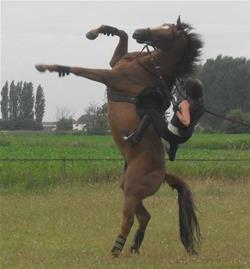How To Tell If Your Horse Has Shut Down
Did you know that some horses ‘shut down’ their emotions while still doing what is asked?
The stillness that is the result of a tight and tense horse is often mistaken for calmness - until the horse overreacts
When your horse shuts down, it is a coping mechanism for not knowing what is expected of them and being scared of the consequences of doing the wrong thing. What is thought of as your horse being calm and relaxed because they are standing still is actually them choosing to do nothing to avoid the consequences of the wrong behaviour.
When this occurs in training, the horse stops learning and engaging with us and starts trying to protect itself. Rather than them learning how to process the training cues with calm relaxation, they are tight and tense on the brink of being tripped over into a fear state. This stillness that is the result of being tight and tense not knowing what to do is often mistaken for a calm, quiet horse. The horse hits its threshold for what it can cope with and all of a sudden overreacts leaving the owner/trainer saying “where the hell did that come from?”
Being shut down is also like learned helplessness. Learned helplessness is a shut down state but not all horses that are shut down are in a learned helplessness state.
Signs your horse has shut down:
Horse stops responding to whips, spurs and being led by the halter or bridle
The horse is unresponsive to a lot of stimuli (typically called a bomb proof horse) when trainers train desensitisation without training how to process, relax and breath through fear, the horse learns to just not to react to things it is scared of.
Horse is standing perfectly still but standing tense and not breathing deeply. Their posture is guarded, they know where their exits are and ready to run, if there are no exits they will be getting ready to fight.
Horse unexpectedly over reacts like launching into the air, broncing, bolting or lunging out at you with their teeth or legs.
Avoid contact. They don’t try to initiate conversation with you and actively avoid you by not looking you in the eye, not touching you with their nose, standing perfectly still when you pat them and sometimes flinching at your touch.
The horse doesn’t exhibit the normal stress signs because it is like a dissociative state. They have “left the building”, disconnected from their body.
Your horse is often trying to communicate it is uncomfortable when it is shut down before it stops coping. This is why with the way we train we try to encourage our horses to tell us they have a problem before they have a big problem. The signs are often very subtle however and often missed.
It can be the swish of a tail, the stomp of a hoof, the toss of the head, the swivel of the ears. This is where knowing your horse becomes so important and also why we use pressure release the way we do. Your horse can do these things as a little grumble and protest but then chooses to work with you. Other horses will do this as a sign to say back off I’m not coping. Its important to learn how much pressure your horse can cope with before they aren’t coping anymore, what behaviour they show when not coping, how they communicate to back off and what you need to do to help soothe them back into a state of processing cues again.
Over time as your relationship and trust builds your horse should become less sensitive and more willing to your asks but only because they know you are listening to them and respecting their boundaries they allow you to ask more of them.
Using tactics to scare, intimidate and bully horses into submission is a common training tool used today. And, because it works, it continues to be used. It’s how I was initially taught to train. “Be scarier than the thing your horse is scared of”. However, I also learnt to train by teaching beginners who aren’t strong enough, coordinated or savvy enough to get a horse to cooperate through these tactics and so had to find another way they could get their horses to not only do as they asked but also to look after them.

